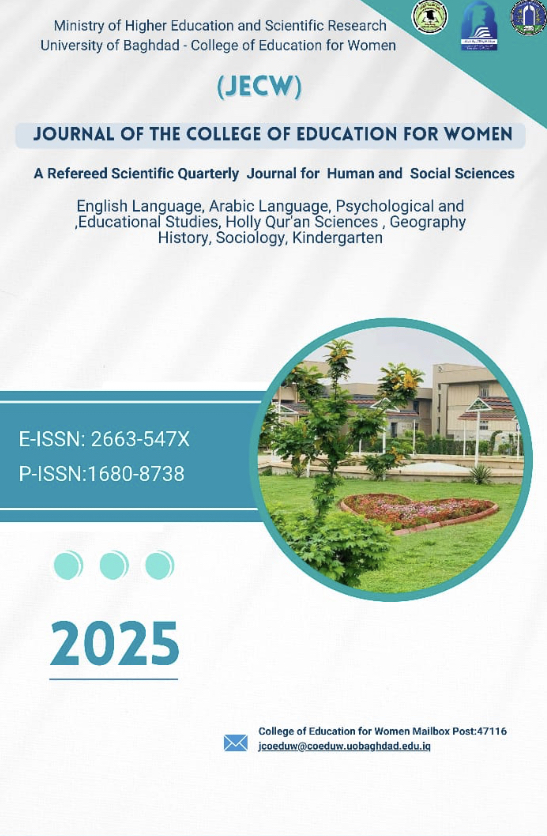Abstract
This research seeks to unravel the components of
the argumentative discourse in the Book of ʻRawdat alMuhebbeen wa Nozhatt al-Mushtaqeenʼ - The Garden of
Lovers and the Promenade of Longing People – by Ibn
Al-Qayyem Al-Jawziyah. This is because this book has a
moderate discourse with a sound Islamic thought that is
characterized by its sustainability, popularity, realism, and
interaction with the successive developments of the new
age. This reflects the intellectual maturity the composing
process has reached in the philosophy of love and its
educational bases in every place and time. To explore the
componets, properties, and the working mechanisms of an
argumentative discourse in Ibn Qayyem’s book, the
present work has been conducted using a pragmatic
closeness approach among the three communication
polars: (sender, receiver, and message). Through the third
pole, the researcher attempts to interpret the text
internally, shedding light on its philosophical and
aesthetic semantic significance. Such a type of analysis
helps reveal the logical argument that conforms to the
spirit of the age during which the book appeared. This can
be clarified by exploring the sender’s employed emotional
arguments that are connected to the recipient and his
persuasive realistic experiences. All the above discussion
reveals the secrets of a discourse and its hidden points,
establishes the values of a dialogue and persuasion,
accepts the differences, and reconciles between the
different opinions. Accordingly, an argumentative entery
has been chosen as it represents a communicative act that
is based on a set of interactive rules orienting
interlocuters’ intentions
the argumentative discourse in the Book of ʻRawdat alMuhebbeen wa Nozhatt al-Mushtaqeenʼ - The Garden of
Lovers and the Promenade of Longing People – by Ibn
Al-Qayyem Al-Jawziyah. This is because this book has a
moderate discourse with a sound Islamic thought that is
characterized by its sustainability, popularity, realism, and
interaction with the successive developments of the new
age. This reflects the intellectual maturity the composing
process has reached in the philosophy of love and its
educational bases in every place and time. To explore the
componets, properties, and the working mechanisms of an
argumentative discourse in Ibn Qayyem’s book, the
present work has been conducted using a pragmatic
closeness approach among the three communication
polars: (sender, receiver, and message). Through the third
pole, the researcher attempts to interpret the text
internally, shedding light on its philosophical and
aesthetic semantic significance. Such a type of analysis
helps reveal the logical argument that conforms to the
spirit of the age during which the book appeared. This can
be clarified by exploring the sender’s employed emotional
arguments that are connected to the recipient and his
persuasive realistic experiences. All the above discussion
reveals the secrets of a discourse and its hidden points,
establishes the values of a dialogue and persuasion,
accepts the differences, and reconciles between the
different opinions. Accordingly, an argumentative entery
has been chosen as it represents a communicative act that
is based on a set of interactive rules orienting
interlocuters’ intentions
Keywords
Argumentation
Ibn Al-Qayyem
ʻRawdat alMuhebbeenʼcommunication
Abstract
يسعى هذا البحث إلى الكشف عن مقومات الخطاب الحجاجي في
كتاب )روضة المحبين ونزهة المشتاقين(، البن القيم الجوزية، بوصفه
خطابًا معتدالً، يحمل فكًرا إسالميًا رصينًا، يتسم باالستمرارية، والشهرة،
والواقعية، والقدرة على التفاعل مع مستجدات العصور المتالحقة، وهذا مما
يعكس النضج الفكري، الذي وصل إليه التأليف في فلسفة الحب، وما يتمتع
به من أسس تربوية صالحة لكل زمان ومكان. وللكشف عن مكونات
الخطاب الحجاجي، وخصائصه، وآليات اشتغاله في كتاب ابن القيم، تقترح
الدراسة مقاربة تداولية، تستهدف أقطاب التواصل )المرسل، و المستقبل، و
الرسالة(، ومن خالل القطب الثالث، تُقدم الدراسة محاولة تأويل محايث؛
لتحاور النص السردي من داخله، وتستنطق دالالته الفلسفية والجمالية؛
لتكشف عن جدل منطقي، يتوافق مع روح العصر الذي ظهر فيه الكتاب،
يتضح ذلك عن طريق الكشف عما وظفه المر ِسل من حجج عاطفية تتصل
بالسمات األخالقية، للمرسل، وبما يحمله من تجارب ذات سمة واقعية، لها
دورها في إقناع المتلقي، وجميع ما سبق يستهدف الكشف عن أسرار
الخطاب واستجالء خباياه، التي ترسخ قيم الحوار واإلقناع وتقبل االختالف
بإيراد الرأي والرأي المخالف، ومحاولة التوفيق بينهما؛ ولذلك اخترنا
المدخل الحجاجي، كونه فعال تواصليًا، ينهض على جملة من القواعد
التفاعلية، التي توجه مقاصد المتخاطبين.
كتاب )روضة المحبين ونزهة المشتاقين(، البن القيم الجوزية، بوصفه
خطابًا معتدالً، يحمل فكًرا إسالميًا رصينًا، يتسم باالستمرارية، والشهرة،
والواقعية، والقدرة على التفاعل مع مستجدات العصور المتالحقة، وهذا مما
يعكس النضج الفكري، الذي وصل إليه التأليف في فلسفة الحب، وما يتمتع
به من أسس تربوية صالحة لكل زمان ومكان. وللكشف عن مكونات
الخطاب الحجاجي، وخصائصه، وآليات اشتغاله في كتاب ابن القيم، تقترح
الدراسة مقاربة تداولية، تستهدف أقطاب التواصل )المرسل، و المستقبل، و
الرسالة(، ومن خالل القطب الثالث، تُقدم الدراسة محاولة تأويل محايث؛
لتحاور النص السردي من داخله، وتستنطق دالالته الفلسفية والجمالية؛
لتكشف عن جدل منطقي، يتوافق مع روح العصر الذي ظهر فيه الكتاب،
يتضح ذلك عن طريق الكشف عما وظفه المر ِسل من حجج عاطفية تتصل
بالسمات األخالقية، للمرسل، وبما يحمله من تجارب ذات سمة واقعية، لها
دورها في إقناع المتلقي، وجميع ما سبق يستهدف الكشف عن أسرار
الخطاب واستجالء خباياه، التي ترسخ قيم الحوار واإلقناع وتقبل االختالف
بإيراد الرأي والرأي المخالف، ومحاولة التوفيق بينهما؛ ولذلك اخترنا
المدخل الحجاجي، كونه فعال تواصليًا، ينهض على جملة من القواعد
التفاعلية، التي توجه مقاصد المتخاطبين.
Keywords
ابن القيم، التواصل، الحجاج، روضة المحبين
